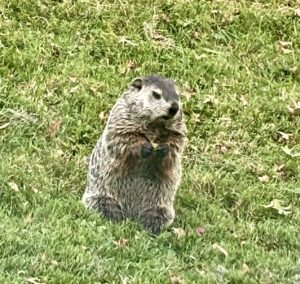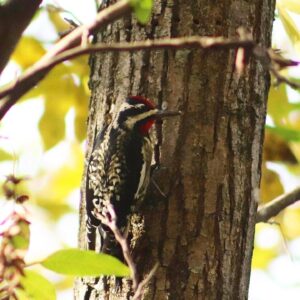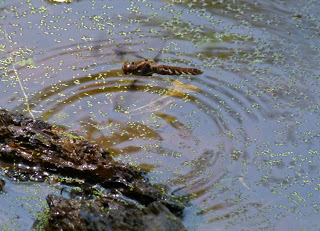 |
| Female Common Whitetail hovers over the pond, making ripples like a helicopter |
At NatureFest on Saturday, Dr. Bill Dean helped us explore the aquatic animals usually unseen in the mud and duck weed of Frog Pond. With his net, he dredged up tadpoles of all sizes, small frogs, immature salamanders, and the nymphs of immature dragonflies. Dragonflies are fascinating insects which are mighty predators and fiercely territorial.
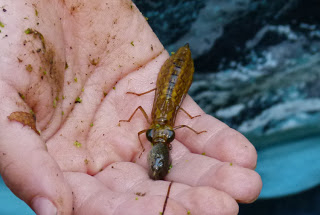 |
| Dragonfly nymph eating a tadpole |
The dragonfly begins its life as an egg. Adult female dragonflies lay their eggs in water and after about two weeks, the eggs hatch and an immature dragonfly, or nymph, emerges. The nymphs are not pretty like the adults. They have tiny wings and a large lower lip, which they use to catch their prey (often mosquito larvae). Dragonfly nymphs live in the water. As they grow, they molt (shed their skin). Nymphs of some species may take as long as three years to mature. When the dragonfly nymph reaches maturity, it crawls out of the water onto a plant stem. Then its skin begins to split. First the head, then the thorax, then the legs, and then the wings of an adult dragonfly emerge. Soon the newly emerged dragonfly is able to fly. The process takes about two hours. It takes about two days before the adult dragonfly’s beautiful colors are fully developed. Adult dragonflies live only a few months.
 |
| Halloween Pennant Dragonfly |
Dragonflies are ancient insects. They were around before the dinosaurs! Ancient dragonflies may have been considerably larger than those we see today. A fossilized impression of a dragonfly wing, found in a coal mine in England, is the oldest known dragonfly specimen. This dragonfly lived 300 million years ago and had a wingspan of eight inches. The largest known dragonfly had a wingspan of 24 inches (two feet). Today, the largest dragonfly is found in South America and has a wingspan of slightly over seven inches. Other than being smaller, modern-day dragonflies do not look very different from their ancestors.
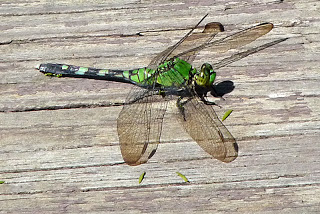 |
| Eastern Pondhawk |
Dragonflies’ ability to maneuver makes them able to out-fly their prey. But dragonflies also have the advantage of excellent eyesight. If you’ve ever watched dragonflies, no doubt you have noticed their huge eyes. Each of the two large eyes is made up of thousands of six-sided units. Together, these smaller eyes enable a dragonfly to detect even the slightest movement. To test this, try sneaking up and catching a dragonfly. You usually come up empty-handed. Although we expect to find them around a pond, dragonflies can travel far beyond the nearest source of water. Sometimes you may see them attacking their reflections on a shiny car window.
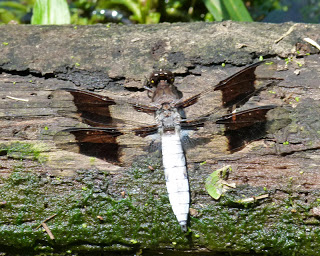 |
| Common Whitetail – Male |
The common whitetail dragonfly is very, well, common around the Frog Pond. You’ll easily recognize it by the white tail, of course.
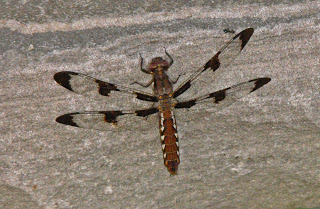 |
| Female Whitetail |
But the female whitetail looks quite different. In fact, I always have to look this one up, since not only does she not have a white tail, but she even has a different number of spots on her wings, which seems odd to me.
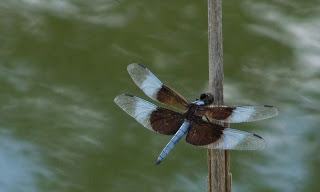 |
| Widow Skimmer |
When I hear the name “dragon fly,” I can’t help remembering the small dragons flying around in Disney’s Alice in Wonderland. How did they get their names? Many sources say the name comes from their fierce jaws, which they use to catch flies (among other winged insects). Names like Darter, Dancer, Hawk, Glider, and Skimmer all come from the way they fly and hunt. Some are called Darner, based on an old myth that dragonflies would come and sew your lips together, and since some are thin as needles you can see where this might arise.
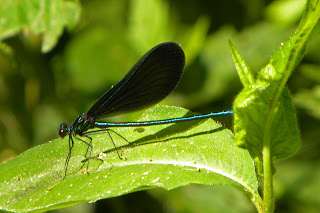 |
| Ebony Jewelwing Damselfly |
If you walk along Little Huckleberry Creek, you will see lots of the ebony jewelwing – a damselfly. Damsels and dragons – this is starting to sound like a video game! Damselflies have four wings, but when they land, they fold up their wings so only two are visible. These dark beauties have an iridescent body that may appear black, blue, green or even bronze depending on the light. The female also has a small white spot on the wingtips displayed when she lands. They love the moist habitat of small streams.
Naturally yours,
~denapple

